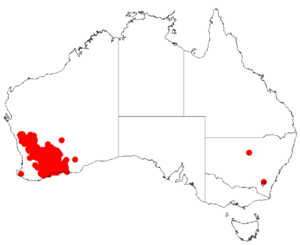Fine-leaf wodjil facts for kids
Quick facts for kids Fine-leaf wodjil |
|
|---|---|
| Scientific classification | |
| Genus: |
Acacia
|
| Species: |
assimilis
|
 |
|
| Acacia assimilis occurrence data from Australasian Virtual Herbarium | |
Acacia assimilis, also called the fine-leaf wodjil, is a type of shrub or small tree. It belongs to the Acacia family, which is a large group of plants. This plant is special because it only grows naturally in the southwest part of Australia. When a plant or animal only lives in one specific area, we say it is endemic there.
What Does Acacia assimilis Look Like?
This plant is usually a rounded, bushy shrub or a small tree. It can grow to be about 1 to 4 metres (3 to 13 ft) tall. Its small branches are smooth (meaning they have no hairs) and round. When new shoots grow, they are yellow and covered in many tiny hairs.
Like most Acacia plants, the fine-leaf wodjil has special leaf-like parts called phyllodes. These are not true leaves but look and act like them. The phyllodes are green and become smooth as they get older. They stick out or grow upwards. Each phyllode is very thin and thread-like (this is called filiform). They can be straight or slightly curved.
Each phyllode is about 5 to 14 cm (2.0 to 5.5 in) long. They are quite narrow, only about 0.8 to 1.3 mm (0.031 to 0.051 in) wide. If you look closely, you will see many thin lines running side-by-side along the phyllode. These are called nerves. The fine-leaf wodjil produces yellow flowers. It can bloom at any time of the year, from January to December.
Types of Acacia assimilis
Scientists sometimes divide plants into smaller groups called varieties. This helps them study the small differences within a species. For Acacia assimilis, there are two main types that scientists recognize:
- Acacia assimilis var. assimilis
- Acacia assimilis var. atroviridis
Where Does Acacia assimilis Grow?
The fine-leaf wodjil grows naturally in several regions of Western Australia. These areas include the Wheatbelt, Great Southern, and Goldfields-Esperance regions.
You can often find this plant in sandy flat areas (called sandplains). It also grows in low-lying spots, near large rock formations made of granite, and on rocky hills. It prefers to grow in sandy or loamy soils that have some gravel. These soils are usually found over granite rock or a hard, reddish soil layer called laterite.

